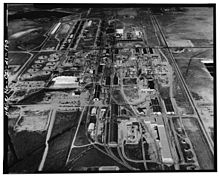Rocky Mountain Arsenal
The Rocky Mountain Arsenal was a United States chemical weapons manufacturing center located in the Denver Metropolitan Area in Commerce City, Colorado.
The site was completed December 1942,[1] operated by the United States Army throughout the later 20th century and was controversial among local residents until its closure in 1992.
After the attack on Pearl Harbor and the United States' entry into World War II, the U.S. Army began looking for land to create a chemical manufacturing center.
The U.S. Congress responded to the movement in 1980 with the creation of the Comprehensive Environmental Response, Compensation, and Liability Act (CERCLA), most commonly referred to as a Superfund.
[2] After 42 years of chemical manufacturing, in 1984, the United States Army began to inspect the level of contamination at Rocky Mountain Arsenal (RMA).
Included in the RMANWR Act, areas within RMA that were still contaminated were still owned by the U.S. Army, however, the vast majority of the land that was deemed clean would be managed by the Federal Fish and Wildlife Service (FWS).
[5] In 1942, the US Army acquired 19,915 acres (80.59 km2) of land on which to manufacture weapons in support of World War II military activities at a cost of $62,415,000.
Additionally, some of this land was used for a prisoner of war camp (for German combatants) and later transferred to the city of Denver as Stapleton Airport expanded.
In 1984, the Army began a systematic investigation of site contamination in accordance with the Comprehensive Environmental Response, Compensation, and Liability Act of 1980 (CERCLA), commonly referred to as Superfund.
The primary contaminants include organochloride pesticides, organophosphate pesticides, carbamate insecticides, organic solvents and feedstock chemicals used as raw products or intermediates in the manufacturing process (e.g., chlorinated benzenes), heavy metals, chemical warfare material and their related breakdown products and biological warfare agent such as TX.
From 1943 to 1956, the US Army and Shell discharged wastes into the unlined basins resulting in the contamination of the South Platte River outside the Arsenal.
The Army and Shell took remedial actions to prevent the contamination that includes the installation of the groundwater barrier system which treated approximately 1 billion gallons of water every year.
[12] Though the cleanup of the site was considered complete in 2010, soil and groundwater monitoring practices occur every five years to ensure the effects of the clean-up remain.
Many of the surrounding neighborhoods have been provided with potable tap water from other areas of Adams county because of the potential effects of contaminated groundwater from wells.
Longstanding agricultural and health concerns related to the Rocky Mountain Arsenal have resulted in a complex history of political and legal battles.
Heavy volatile contaminants related to Basin F raised concern among the public for the site and the process of the clean-up itself of the Arsenal and a medical monitoring program (MMP) was put in place as part of the Record of Decision (ROD) between the U.S. Army, the U.S. Environmental Protection Agency, and the Colorado Department of Health and Environment in 1996.
[14] The following data were derived from the Rocky Mountain Arsenal Medical Monitoring Program Surveillance for Birth Defects Compendium prepared by Colorado Department of Public Health and Environment and published in February 2010.
These potential confounders are not clearly addressed in this report and may complicate the analysis as well as raise concern for disparities in exposure risk that is dependent upon demographic factors.
Baseline rates of congenital anomalies in the study area compared to Colorado as a whole did not show significant differences between populations.
A separate study of cancer incidence by the Colorado Department of Health did not find convincing evidence of increased cancer risk in people living in residential areas surrounding the arsenal,[15] although the study was made more difficult by the large demographic changes in the area and was also confounded by smoking and obesity rates.
Additionally, studies performed at Colorado State University found no increased risk of Arsenic, Mercury, or neurotoxicity in communities within 15 miles of the RMA.
A more recent article in 2004 by Pimentel,[19] estimated the cost of removal pesticides from the groundwater and soil at the Rocky Mountain Arsenal by approximately $2 billion.
The Rocky Mountain Arsenal National Wildlife Refuge Act was passed in October 1992 and signed by President George H. W. Bush.
On May 21, 2011, the official visitor center for the refuge was opened with an exhibit about the site's history, ranging from the homesteading era to its current status.
In April 2007 Dick's Sporting Goods Park, a soccer-specific stadium, was opened on part of the former Rocky Mountain Arsenal land that was transferred to Commerce City.





